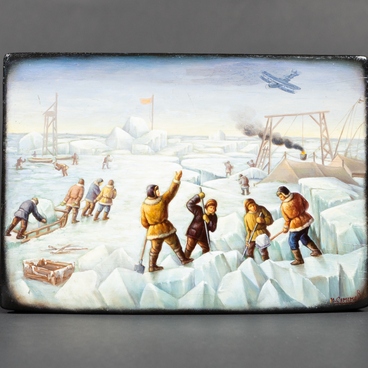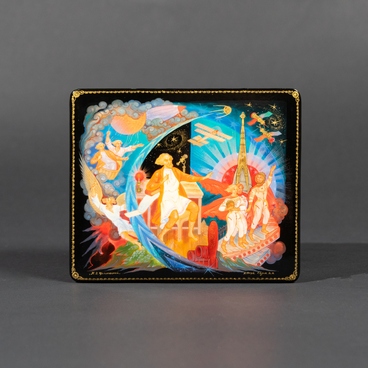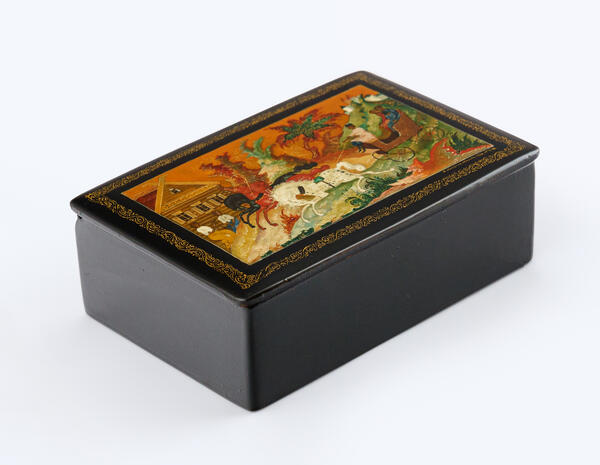The plate with the image of the Palace of the Soviets was made by Alexander Kotyagin, one of the founders of Mstyora lacquer miniature. Although Kotyagin was a professional icon painter, he was one of the first masters to depict contemporary life: the artist reflected on the achievements and projects of the Soviet state in his works.
The Palace of the Soviets was a grandiose architectural project in the Soviet Union, which only remained on paper. According to the plan, it was supposed to be a high-rise administrative building in the center of Moscow, which would house sessions of the Supreme Soviet of the USSR.
Organizational issues for the construction of the Palace were handled by the Temporary Technical Council, which included not only architects, but also prominent cultural figures. Those included writer Maxim Gorky, artist Igor Grabar, theater practitioner Konstantin Stanislavsky.
The laying of the foundation began in 1932 on the site of the Cathedral of Christ the Savior, which had been blown up. After an All-Union competition, the project of architect Boris Iofan was adopted as a basis and finalized with the participation of Vladimir Helfreich and Vladimir Shchuko. According to the plan, the building was supposed to have a giant statue of Vladimir Lenin on top — a sculpture by Sergey Merkurov. The Palace of the Soviets was to become the first Soviet skyscraper and the most important symbol of the socialist state.
The foundation of the building was completed by 1939, but in 1941 the construction was interrupted due to the outbreak of the Great Patriotic War. The already erected steel frame of seven floors was used to produce anti-tank hedgehogs — special barriers made of rebar.
As the building of the Palace of the Soviets was never built, on Kotyagin’s miniature it looks rather conventional, as if the artist copied it using carbon paper from architectural plans and transferred it to the papier mâché plate. The march happening along the embankment is also depicted conventionally: the master captured red banners and signs, as well as white squares with portraits and slogans. In the foreground, the master depicted a balcony with a family looking at the procession. This detail made the composition more realistic.
The Palace of the Soviets was a grandiose architectural project in the Soviet Union, which only remained on paper. According to the plan, it was supposed to be a high-rise administrative building in the center of Moscow, which would house sessions of the Supreme Soviet of the USSR.
Organizational issues for the construction of the Palace were handled by the Temporary Technical Council, which included not only architects, but also prominent cultural figures. Those included writer Maxim Gorky, artist Igor Grabar, theater practitioner Konstantin Stanislavsky.
The laying of the foundation began in 1932 on the site of the Cathedral of Christ the Savior, which had been blown up. After an All-Union competition, the project of architect Boris Iofan was adopted as a basis and finalized with the participation of Vladimir Helfreich and Vladimir Shchuko. According to the plan, the building was supposed to have a giant statue of Vladimir Lenin on top — a sculpture by Sergey Merkurov. The Palace of the Soviets was to become the first Soviet skyscraper and the most important symbol of the socialist state.
The foundation of the building was completed by 1939, but in 1941 the construction was interrupted due to the outbreak of the Great Patriotic War. The already erected steel frame of seven floors was used to produce anti-tank hedgehogs — special barriers made of rebar.
As the building of the Palace of the Soviets was never built, on Kotyagin’s miniature it looks rather conventional, as if the artist copied it using carbon paper from architectural plans and transferred it to the papier mâché plate. The march happening along the embankment is also depicted conventionally: the master captured red banners and signs, as well as white squares with portraits and slogans. In the foreground, the master depicted a balcony with a family looking at the procession. This detail made the composition more realistic.



